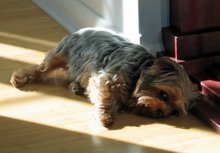skip to main |
skip to sidebar
Le Memorial de Caen and Arromanches-les-Bains
On the second day of our vacation we decided to tour the World War II sights of Normandy. We began our day in Caen, at the museum and memorial known as "Le Memorial". This is an excellent museum that walks you through the years leading up to the war, through the war, and then finishes with a display on the cold war. You start your tour at the top of a large spiral ramp with displays covering World War I, and you follow the ramp down the years and basically "spiral down into war". At the bottom of the ramp and throughout the basement of the museum are the WWII displays, focusing mostly on the European theatre, the soldiers who fought there, and the people who lived there. The museum also had a really interesting short film called "Le Jour J" (D-Day). It was done in a split-screen style, with one half of the screen showing the activities of the allies, and the other half showing the simultaneous activities of the Germans on that day. I wouldn't say it was a fun place to visit, but it certainly gave us a good background for what we would see the rest of the day, and it did an excellent job of reminding us of the necessity and the cost of war.




We grabbed a quick bite to eat at the museum cafe for lunch, and then headed north to the coast to the town of Arromanches-les-Bains. As we neared the town, we encountered humongous tour buses full of Brits and Germans driven by crazy drivers that were attempting to navigate impossibly narrow and twisty roads. I was pretty sure we'd be squished a few times, but we managed to make it by them with a couple inches to spare.
We eventually made it to the coast where we found Port Winston, one of two Mulberry harbors anchored on the north coast on Normandy during the war. They were assembled in England, then towed across the English Channel to be anchored. "Mulberry A" was anchored on Omaha Beach, and was used by the Americans. It didn't last long as it wasn't very well anchored. "Mulberry B" did much better, and parts of it have lasted to this day.
The artificial harbor featured huge breakwaters made from concrete-filled caissons sunk in the seabed. Those formed a protective barrier around the piers. Some of the piers were light metal stages resting on floats, and others were anchored to the sea-bed. Most of the pieces of the harbor have either sunk or floated away over the years, but a few remain. There's a museum at the beach that I'm sure would have been interesting to go through, but we skipped it in favor of being able to see more sights.
 The remains of the piers are in the foreground.
The remains of the piers are in the foreground.
 Off in the distance you can see what's left of the breakwaters.
Off in the distance you can see what's left of the breakwaters.
 It was a bit windy that day.
It was a bit windy that day. This is a section of a pier.
This is a section of a pier.

 This is one of the anchors.
This is one of the anchors.






















No comments:
Post a Comment